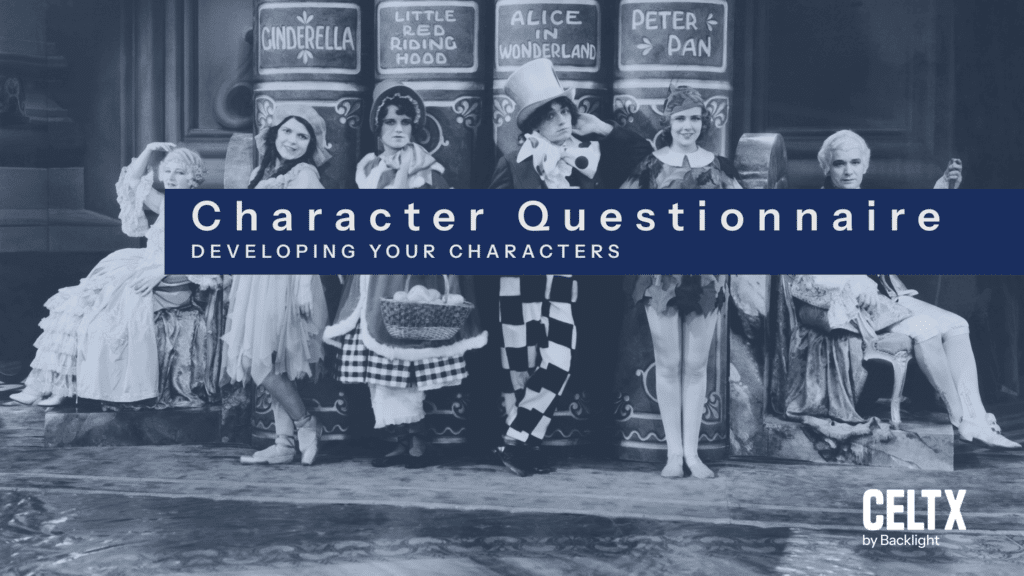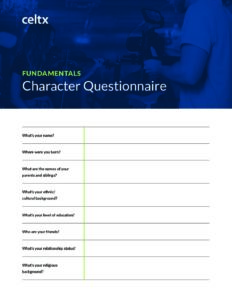
One of the most common notes screenwriters hear? “Your character feels flat.” Or maybe: passive, inconsistent, underdeveloped. And more often than not, the reason is simple—writers haven’t spent enough time getting to know the people they’re writing.
Great characters don’t appear out of nowhere. They’re built with intention.
So how do you build a character that feels real, layered, and alive on the page? You start by asking questions.
What is a Character Questionnaire?
A character questionnaire is a tool to help you explore who your character is—beyond what’s on the surface.
When you answer detailed questions about your character’s life, history, relationships, and worldview, you start to understand not only what they do in a story, but why they do it. That context helps you write more consistent, emotionally grounded characters that react in ways that feel authentic—even when they’re unpredictable.
This isn’t just about listing facts like height, hometown, or favorite color. A good character questionnaire uncovers motivations, past wounds, core beliefs, and how those things shape the way your character moves through the world.
As with all our lessons so far, you need to write this stuff down. Don’t try to hold the entire character in your head; that’s an easy way to write characters that are just you.
To help you get your characters out of your head and onto paper, we’ve put together a free, downloadable Character Questionnaire with 20 thoughtful questions to help you build stronger characters, faster.
Why It Works
You don’t need to use every detail from the questionnaire in your script—but the answers can subtly shape how your character shows up.
For example:
- A strained relationship with a parent might influence how they speak to an authority figure.
- An embarrassing childhood memory could shape their confidence in social situations.
- Past betrayal might lead them to push away people they actually care about.
You see these kinds of layered relationships in every story that leaves a lasting impact. From the lifelong, deeply fractured bond between Prince Zuko and his father, Fire Lord Ozai, in Avatar: The Last Airbender, to the quiet tension simmering between Lady Bird and her mother in Lady Bird. These dynamics shape how characters speak, what they hide, what they fight for—and what they avoid entirely.

These nuances add up. And when your characters feel real to you, it’s easier to write dialogue, conflict, and even action scenes that reflect who they truly are.
👉 Want to go deeper? Try pairing this with our blogs on character arcs, character profiles, and how to write strong dialogue.
A Note on Subtext (and Why Knowing Your Characters Matters)
Here’s where things get juicy: Subtext.
When you know your character’s emotional baggage, every interaction becomes more layered. A simple dinner conversation hits different if your characters just had a fight. Or if one of them is secretly keeping a huge secret. Or if they’re trying not to show how much the other person’s approval means to them.
It’s not about what they’re saying—it’s about why they’re saying it that way.
Backstory gives you that. It makes scenes more than just talk; it makes them tension-filled, meaningful, and real.
For more on subtext: read our deep dive into how to say more by saying less!
How to Use the Character Questionnaire
- Start with your protagonist. Answer the questions in first person, like the character is being interviewed.
- Once you’ve got the hang of it, move on to your supporting cast and antagonist
- Ask questions that connect characters:
- What does Character A think Character B will do if they find out their secret?
- How does Character C feel about Character D’s success?
This kind of relational thinking helps you build stronger dynamics between your characters—and that means stronger scenes.
Think about Jack and Rose in Titanic. She’s a wealthy young woman, suffocating under societal expectations. He’s a free-spirited artist with nothing but his sketchbook and a ticket won in a card game. Their backstories shape everything: Rose’s guarded nature, Jack’s confidence in chaos, their chemistry, and ultimately—why their connection feels so electric and inevitable. Knowing who your characters are before they meet changes how they meet, what they say, and what they risk.

Pro tip: Use Celtx to store your character profiles and track how they evolve as you write.
Build Your Character Bible
Once you’ve filled out the questionnaire for each major character, you’ll have the beginnings of a character bible: a living document that keeps your cast consistent across your entire story.
And when the writing gets tough (because it will), that character bible becomes your anchor. Instead of guessing what your character might do, you’ll know—because you’ve already spent the time getting to know them.
Ready to write? Start your free Celtx trial and develop your characters directly in your script.
Looking for more writing help?
- How to Write a Screenplay Outline
- 10 Must-Know Tips for Researching Your Screenplay
- 15 Essential Character Archetypes (And How to Use Them)

